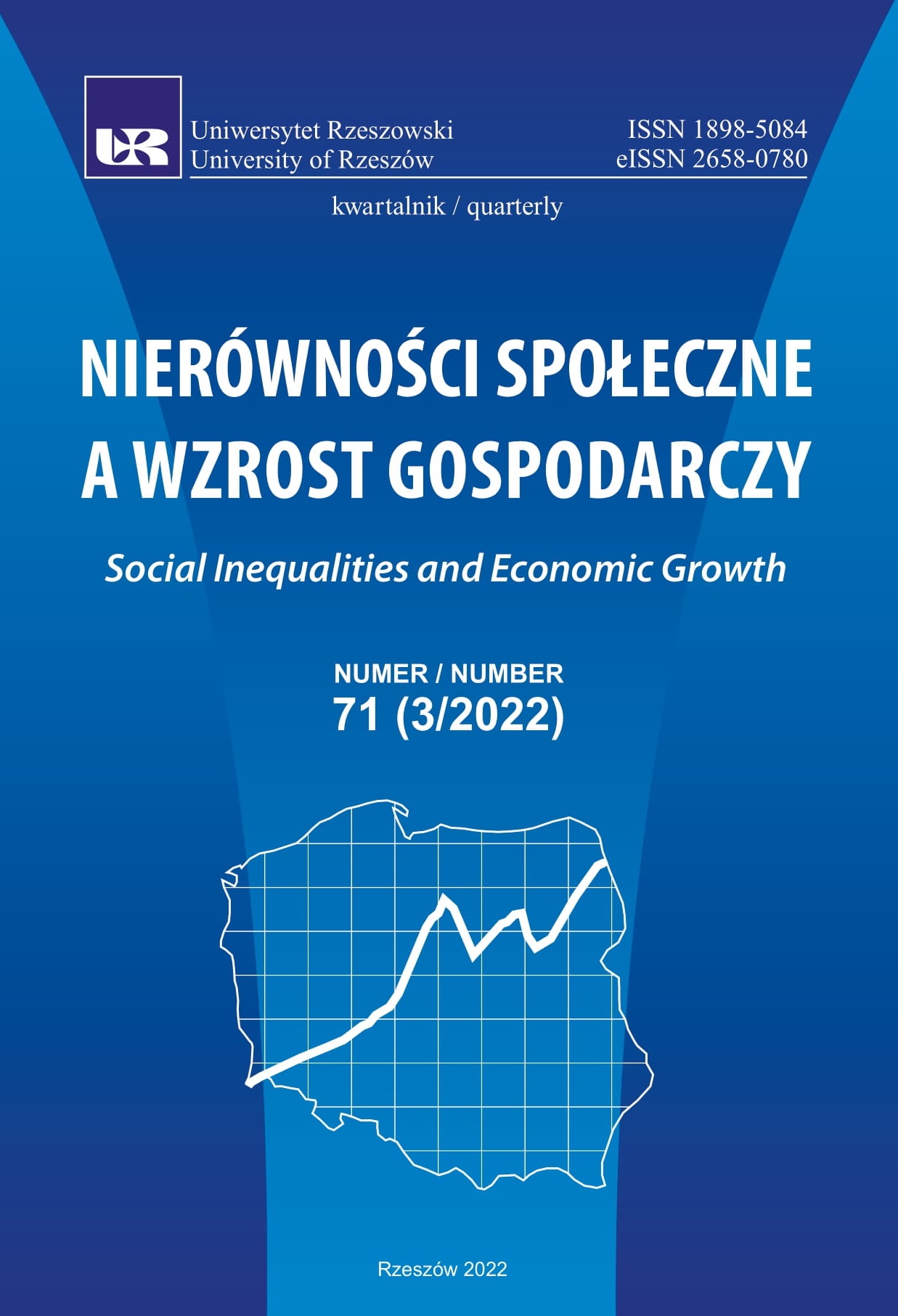Thermodynamic approach to the theory of fair remuneration
DOI:
https://doi.org/10.15584/nsawg.2022.3.2Keywords:
fair wage, thermodynamics, economic constant, fundamental principlesAbstract
Limiting itself within the framework of this article only to the issues of the theory of fair remuneration, the key questions are: what is the criterion of fair remuneration, where does it come from, and where to look for it? The main purpose of this article is to present a model of a fair wage in terms of the fundamental principles of thermodynamics. In an economic interpretation, this is the principle of preservation of capital and the principle of its spontaneous and random dissipation, which is related to the second principle of thermodynamics. Based on thermodynamic knowledge of the functioning of the human body as an abstract heat engine, a thermodynamic model of a fair wage was presented, which consists in compensating the worker for the natural dissipation of their personal capital. It was confirmed that, as a result of the application of this principle of remuneration, the earnings of two working parents make it possible to bring two descendants to the level of human capital they have achieved: that is, this wage guarantees the preservation of human capital in the family.
Downloads
References
Adamczyk, A. (2008). Entropia. II Prawo (zasada) termodynamiki. Lectures and Animations in General Physics. Pobrane z: http://www.if.pw.edu.pl/~anadam/WykLadyFO/FoWWW_27.html (2020.08.27).
Atkins, P. (2005). Palec Galileusza. Dziesięć wielkich idei nauki. Poznań: Dom Wydawniczy Rebis.
Atkins, P. (2007). Four Laws that Drive the Universe. New York: Oxford University Press.
Cieslak, I. (2008). Value of Human Capital and Wage Disparities. W: I. Górowski (red.), General Accounting Theory Evolution and Design for Efficiency (s. 289–303). Warszawa: Wydawnictwa Akademickie i Profesjonalne.
Dobija, M. (red.). (2010). Teoria pomiaru kapitału ludzkiego. Kraków: Wydawnictwo Uniwersytetu Ekonomicznego w Krakowie.
Dobija, M. (1998). How to place human resources into the balance sheet. Journal of Human Resource Costing & Accounting, 3(1), 83–92.
Dobija, M. (2007). Abstract Nature of Capital and Money. W: M.L. Cornwall (red.), New Developments in Banking and Finance (s. 89–114). New York: Nova Science Publishers.
Dobija, M. (2011). Abstract Nature of Money and the Modern Equation of Exchange. Modern Economy, 2(2),142–152. DOI: 10.4236/me.2011.22019.
Dobija, M. (2013). Fundamentalne zasady leżące u podstaw nauki rachunkowości. Zeszyty Teoretyczne Rachunkowości, 70(126), 43–62.
Dobija, M., Kurek, B. (2013). Towards Scientific Economics. Modern Economy, 4(4), 293–304. DOI: 10.4236/me.2013.44033.
Dobija, M., Renkas, J. (2020). Accounting among the Natural Sciences. Modern Economy, 11, 2081–2100. DOI:10.4236/me.2020.1112138.
Dobija, M., Renkas, J. (2021). Termodynamika zwornikiem spójnego systemu ekonomicznego. Nierówności Społeczne a Wzrost Gospodarczy, 68, 37–64. DOI:10.15584/ nsawg.2021.4.3.
Dobija, M., Smaga, E. (1993). Zastosowania matematyki finansowej. Kraków: Akademia Ekonomiczna w Krakowie.
Georgescu-Roegen, N. (1971). The Entropy Law and the Economic Process. Massachusetts: Harvard University Press, Cambridge.
Henderson, D. (2020). Concise Encyclopedia of Economics. François Quesnay. Pobrane z: https://www.econlib.org/library/Enc/bios/Quesnay.html (2022.08.17).
Heryng, Z. (1896). Logika ekonomii. Zasadnicze pojęcia ekonomiczne ze stanowiska nauki o energii. Warszawa: Wydawnictwo „Głosu”.
Kozioł, W. (2011). Stała potencjalnego wzrostu w rachunku kapitału ludzkiego. Nierówności Społeczne w Wzrost Gospodarczy, 19, 252–260.
Kurek, B. (2011). Hipoteza deterministycznej premii za ryzyko. Monografie: Prace doktorskie, nr 10, Kraków: Uniwersytet Ekonomiczny w Krakowie.
Kurek, B. (2012). An Estimation of the Capital Growth Rate in Business Activities. Modern Economy, 3(4), 364–372. DOI:10.4236/me.2012.34047.
Kurek, B., Górowski, I. (2020). Gender and Age as Determinants of Expected Rate of Return on Human Capital. Central European Management Journal, 28(4), 30–50. DOI: 10.7206/cemj.2658-0845.33.
LaRouche, L.H. (1995). A więc chcecie dowiedzieć się wszystkiego o ekonomii. Warszawa: Instytut Schillera.
Mazur, M. (1976). Cybernetyka i charakter. Warszawa: Państwowy Instytut Wydawniczy.
Minimum socjalne. Instytut Pracy i Spraw Socjalnych. Pobrane z: https://www.ipiss.com.pl/?zaklady=minimum-socjalne (2022.09.24).
NBPortal. (2004). Wrogowie merkantylistów – fizjokraci. Historia myśli ekonomicznej. Pobrane z: https://www.nbportal.pl/wiedza/artykuly/historia-mysli-ekonomicznej/wrogowie_merkantylistow_fizjokraci (2022.08.05).
Oliwkiewicz, B. (2020). Oczekiwania płacowe a godziwe wynagrodzenia absolwentów studiów ekonomicznych W: D. Fatuła (red.), Zarządzanie zrównoważonym rozwojem organizacji (s. 67–94). Kraków: Oficyna Wydawnicza AFM.
Pęciak, R. (2016). Idea własności w systemie fizjokratycznym. Studia Ekonomiczne: Zeszyty Naukowe Uniwersytetu Ekonomicznego w Katowicach, 260, 78–88.
Renkas, J. (2017). Wynagrodzenie minimalne a produktywność pracy w gospodarce. Studia Ekonomiczne: Zeszyty Naukowe Uniwersytetu Ekonomicznego w Katowicach, 341, 300–315.
Renkas, J. (2021). An Econometric versus Thermodynamic Approach to Modeling Wage Expectations. W: S. Khalid, P.A. Soliman (red.), International Business Information Management Association (p. 5879–5887). Innovation Management and Information Technology Impact on Global Economy in the Era of Pandemic: Proceedings of the 37th International Business Information Management Association Conference (IBIMA), 30-31 May 2021, Cordoba, Spain.
Renkas, J. (2013). Wage expectations in light of human capital measurement theory. Argumenta Oeconomica Cracoviensia, 9(9), 29–42.
Renkas, J. (2016). Nierówności płacowe a stała ekonomiczna potencjalnego wzrostu. Nierówności Społeczne a Wzrost Gospodarczy, 47(3), 466–480. DOI:10.15584/ nsawg.2016.3.34.
Renkas, J. (2022). Termodynamiczny model pomiaru kapitału ludzkiego w zastosowaniach do kształtowania wynagrodzeń za pracę. Warszawa: Wydawnictwo Difin.
Smith, A. (1776). An Inquiry into the Nature and Causes of the Wealth of Nations. W: E. Cannan, (red). 1904. Book I, 1.5.2. Library of Economics and Liberty. Pobrane z: http://www.econlib.org/library/Smith/smWN2.html (2020.08.17).
Stankiewicz, W. (2000). Historia myśli ekonomicznej. Warszawa: PWE.
Włodarczyk, J. (2008). Ekonomia jako nauka o energii społecznej w polskiej myśli ekonomicznej przełomu XIX i XX wieku. Studia Ekonomiczne. Zeszyty Naukowe Uniwersytetu Ekonomicznego w Katowicach, 54, 39–57.
Downloads
Published
How to Cite
Issue
Section
License
Copyright (c) 2022 University of Rzeszow

This work is licensed under a Creative Commons Attribution-ShareAlike 4.0 International License.


